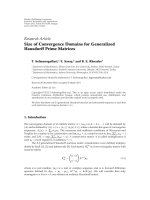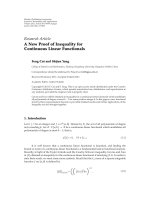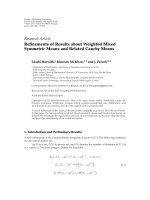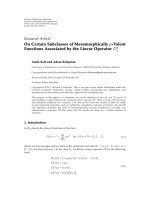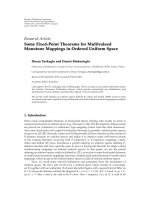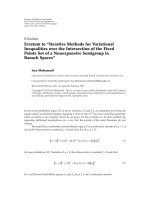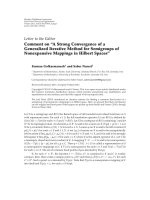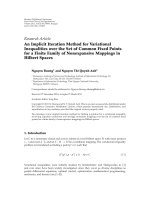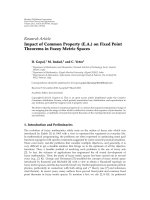Hindawi Publishing Corporation Journal of Inequalities and Applications Volume 2010, Article ID pot
Bạn đang xem bản rút gọn của tài liệu. Xem và tải ngay bản đầy đủ của tài liệu tại đây (503.21 KB, 12 trang )
Hindawi Publishing Corporation
Journal of Inequalities and Applications
Volume 2010, Article ID 850125, 12 pages
doi:10.1155/2010/850125
Research Article
On Integral Operators with
Operator-Valued Kernels
Rishad Shahmurov
1, 2
1
Department of Mathematics, University of Alabama, Tuscaloosa, AL 35487-0350, USA
2
Vocational High School, Okan University, Istanbul 34959, Turkey
Correspondence should be addressed to Rishad Shahmurov,
Received 17 October 2010; Revised 18 November 2010; Accepted 23 November 2010
Academic Editor: Martin Bohner
Copyright q 2010 Rishad Shahmurov. This is an open access article distributed under the Creative
Commons Attribution License, which permits unrestricted use, distribution, and reproduction in
any medium, provided the original work is properly cited.
Here, we study the continuity of integral operators with operator-valued kernels. Particularly we
get L
q
S; X → L
p
T;Y estimates under some natural conditions on the kernel k : T × S →
BX, Y ,whereX and Y are Banach spaces, and T,
T
,μ and S,
S
,ν are positive measure
spaces: Then, we apply these results to extend the well-known Fourier Multiplier theorems on
Besov spaces.
1. Introduction
It is well known that solutions of inhomogeneous differential and integral equations are
represented by integral operators. To investigate the stability of solutions, we often use the
continuity of corresponding integral operators in the studied function spaces. For instance,
the boundedness of Fourier multiplier operators plays a crucial role in the theory of linear
PDE’s, especially in the study of maximal regularity for elliptic and parabolic PDE’s. For an
exposition of the integral operators with scalar-valued kernels see 1 and f or the application
of multiplier theorems see 2.
Girardi and Weis 3 recently proved that the integral operator
Kf
·
S
k
·,s
f
s
dν
s
1.1
defines a bounded linear operator
K : L
p
S, X
−→ L
p
T, Y
1.2
2 Journal of Inequalities and Applications
provided some measurability conditions and the following assumptions
sup
s∈S
T
k
t, s
x
Y
dμ
t
≤ C
1
x
X
, ∀x ∈ X,
sup
t∈T
S
k
∗
t, s
y
∗
X
∗
dν
s
≤ C
2
y
∗
Y
∗
, ∀y
∗
∈ Y
∗
1.3
are satisfied. Inspired from 3 we will show that 1.1 defines a bounded linear operator
K : L
q
S, X
−→ L
p
T, Y
1.4
if the kernel k : T × S → BX, Y satisfies the conditions
sup
s∈S
T
kt, sx
θ
Y
dt
1/θ
≤ C
1
x
X
, ∀x ∈ X,
sup
t∈T
S
k
∗
t, sy
∗
θ
X
∗
ds
1/θ
≤ C
2
y
∗
Y
∗
, ∀y
∗
∈ Y
∗
,
1.5
where
1
q
−
1
p
1 −
1
θ
1.6
for 1 ≤ q<θ/θ − 1 ≤∞and θ ∈ 1, ∞.
Here X and Y are Banach spaces over the field C and X
∗
is the dual space of X.The
space BX, Y of bounded linear operators from X to Y is endowed with the usual uniform
operator topology.
Now let us state some important notations from 3. A subspace Y of X
∗
τ-norms X,
where τ ≥ 1, provided
x
X
≤ τ sup
x
∗
∈BY
|
x
∗
x
|
∀x ∈ X.
1.7
It is clear that if Yτ-norms X then the canonical mapping
u : X −→ Y
∗
with
y, ux
x, y
1.8
is an isomorphic embedding with
1
τ
x
X
≤
ux
Y
∗
≤
x
X
.
1.9
Journal of Inequalities and Applications 3
Let T,
T
,μ and S,
S
,ν be σ-finite positive measure spaces and
finite
S
A ∈
S
: ν
A
< ∞
,
full
S
A ∈
S
: ν
S \ A
0
.
1.10
εS, X will denote the space of finitely valued and finitely supported measurable functions
from S into X,thatis,
ε
S, X
n
i1
x
i
1
A
i
: x
i
∈ X, A
i
∈
finite
S
,n∈ N
.
1.11
Note that εS, X is norm dense in L
p
S, X for 1 ≤ p<∞.LetL
0
∞
S, X be the closure of
εS, X in the L
∞
S, X norm. In general L
0
∞
S, X
/
L
∞
S, Xsee 3, Proposition 2.2 and 3,
Lemma 2.3.
A vector-valued function f : S → X is measurable if there is a sequence f
n
∞
n1
⊂
εS, X converging in the sense of X topology to f and it is σX, Γ-measurable provided
f·,x
∗
: S → K is measurable for each x
∗
∈ Γ ⊂ X
∗
. Suppose 1 ≤ p ≤∞and 1/p 1/p
1.
There is a natural isometric embedding of L
p
T, Y
∗
into L
p
T, Y
∗
given by
f, g
T
f
t
,g
t
dμ
t
for g ∈ L
p
T, Y
∗
,f∈ L
p
T, Y
.
1.12
Now,letusnotethatifX is reflexive or separable, then it has the Radon-Nikodym property,
which implies that EX
∗
E
∗
X
∗
.
2. L
q
→ L
p
Estimates for Integral Operators
In this section, we identify conditions on operator-valued kernel k : T × S → BX, Y ,
extending theorems in 3 so that
K
L
q
S,X → L
p
T,Y
≤ C
2.1
for 1 ≤ q ≤ p. To prove our main result, we shall use some interpolation theorems of L
p
spaces.
Therefore, we will study L
1
S, X → L
θ
T, Y and L
θ
S, X → L
∞
T, Y boundedness of
integral operator 1.1. The following two conditions are natural measurability assumptions
on k : T × S → BX, Y.
4 Journal of Inequalities and Applications
Condition 1. For any A ∈
finite
S
and each x ∈ X
a there is T
A,x
∈
full
T
so that if t ∈ T
A,x
then the Bochner integral
A
k
t, s
xdν
s
exists,
2.2
b T
A,x
: t →
A
kt, sxdνs defines a measurable function from T into Y.
Note that if k satisfies the above condition then for each f ∈ εS, X, there is T
f
∈
full
T
so that the Bochner integral
S
k
t, s
f
s
dν
s
exists
2.3
and 1.1 defines a linear mapping
K : ε
S, X
−→ L
0
T, Y
, 2.4
where L
0
denotes the space of measurable functions.
Condition 2. The kernel k : T × S → BX, Y satisfies the following properties:
a a real-valued mapping kt, sx
θ
X
is product measurable for all x ∈ X,
b there is S
x
∈
full
S
so that
kt, sx
L
θT,Y
≤ C
1
x
X
2.5
for 1 ≤ θ<∞ and x ∈ X.
Theorem 2.1. Suppose 1 ≤ θ<∞ and the kernel k : T × S → BX, Y satisfies Conditions 1 and 2.
Then the integral operator 1.1 acting on εS, X extends to a bounded linear operator
K : L
1
S, X
−→ L
θ
T, Y
. 2.6
Proof. Let f
n
i1
x
i
1
A
i
s ∈ εS, X be fixed. Taking into account the fact that 1 ≤ θ
and using the general Minkowski-Jessen inequality with the assumptions of the theorem we
Journal of Inequalities and Applications 5
obtain
Kft
L
θ
T,Y
≤
⎡
⎣
T
S
kt, s
n
i1
x
i
1
A
i
s
Y
dνs
θ
dμt
⎤
⎦
1/θ
≤
S
⎛
⎝
T
kt, s
n
i1
x
i
1
A
i
s
θ
Y
dμt
⎞
⎠
1/θ
dν
s
≤
S
⎡
⎣
T
n
i1
1
A
i
s
kt, sx
i
Y
θ
dμt
⎤
⎦
1/θ
dν
s
≤
S
n
i1
1
A
i
s
T
kt, sx
i
θ
Y
dμt
1/θ
dν
s
≤
S
n
i1
1
A
i
s
kt, sx
i
L
θT,Y
dν
s
≤ C
1
n
i1
x
i
X
S
1
A
i
s
dν
s
C
1
n
i1
x
i
X
ν
A
i
C
1
f
L
1
S,X
.
2.7
Hence, K
L
1
→ L
θ
≤ C
1
.
Condition 3. For each y
∗
∈ Z there is T
y
∗
∈
full
T
so that for all t ∈ T
y
∗
,
a a real-valued mapping k
∗
t, sx
∗
θ
X
∗
is measurable for all x
∗
∈ X
∗
,
b there is S
x
∈
full
S
so that
k
∗
t, sy
∗
L
θS,X
∗
≤ C
2
y
∗
Y
∗
2.8
for 1 ≤ θ<∞ and x ∈ X.
Theorem 2.2. Let Z be a separable subspace of Y
∗
that τ-norms Y. Suppose 1 ≤ θ<∞ and k :
T × S → BX, Y satisfies Conditions 1 and 3. Then integral operator 1.1 acting on εS, X extends
to a bounded linear operator
K : L
θ
S, X
−→ L
∞
T, Y
. 2.9
Proof. Suppose f ∈ εS, X and y
∗
∈ Z are fixed. Let T
f
,T
y
∗
∈
full
T
be corresponding sets
due to Conditions 1 and 3. By separability of Z, we can choose a countable set of T
y
∗
∈
full
T
satisfying the above condition note that since
full
T
is a sigma algebra, the union of these
6 Journal of Inequalities and Applications
countable sets still belongs to
full
T
and the intersection of these sets should be nonempty.If
t ∈ T
f
∩ T
y
∗
then, by using H
¨
older’s inequality and assumptions of the theorem, we get
y
∗
,
Kf
t
Y
y
∗
,
S
k
t, s
f
s
dν
s
≤
S
k
∗
t, s
y
∗
f
s
dν
s
≤k
∗
t, s
y
∗
L
θ
S,X
∗
f
s
L
θ
S,X
≤ C
2
y
∗
f
L
θ
S,X
.
2.10
Since, T
f
∩ T
y
∗
∈
full
T
and Zτ-norms Y
Kf
L
∞
T,Y
≤ C
2
τf
L
θ
S,X
.
2.11
Hence, K
L
θ
→ L
∞
≤ τC
2
.
In 3, Lemma 3.9, the authors slightly improved interpolation theorem 4, Theorem
5.1.2. The next lemma is a more general form of 3, Lemma 3.9.
Lemma 2.3. Suppose a linear operator
K : ε
S, X
−→ L
θ
T, Y
L
∞
T, Y
2.12
satisfies
Kf
L
θ
T,Y
≤ C
1
f
L
1
S,X
,
Kf
L
∞
T,Y
≤ C
2
f
L
θ
S,X
.
2.13
Then, for 1/q − 1/p 1 − 1/θ and 1 ≤ q<θ/θ − 1 ≤∞the mapping K extends to a bounded
linear operator
K : L
q
S, X
−→ L
p
T, Y
2.14
with
K
L
q
→ L
p
≤
C
1
θ/p
C
2
1−θ/p
.
2.15
Proof. Let us first consider the conditional expectation operator
K
0
f
E
Kf
1
B
|
, 2.16
Journal of Inequalities and Applications 7
where
is a σ-algebra of subsets of B ∈
finite
T
.From2.13 it follows that
K
0
f
L
θ
T,Y
≤ C
1
f
L
1
S,X
< ∞,
K
0
f
L
∞
T,Y
≤ C
2
f
L
θ
S,X
< ∞.
2.17
Hence, by Riesz-Thorin theorem 4, Theorem 5.1.2, we have
K
0
f
L
p
T,Y
≤
C
1
θ/p
C
2
1−θ/p
f
L
q
S,X
.
2.18
Now, taking into account 2.18 and using the same reasoning as in the proof of 3, Lemma
3.9, one can easily show the assertion of this lemma.
Theorem 2.4 operator-valued Schur’s test. Let Z be a subspace of Y
∗
that τ-norms Y and 1/q −
1/p 1 − 1/θ for 1 ≤ q<θ/θ − 1 ≤∞. Suppose k : T × S → BX, Y satisfies Conditions 1, 2,
and 3 with respect to Z. Then integral operator 1.1 extends to a bounded linear operator
K : L
q
S, X
−→ L
p
T, Y
2.19
with
K
L
q
→ L
p
≤
C
1
θ/p
τC
2
1−θ/p
.
2.20
Proof. Combining Theorems 2.1 and 2.2,andLemma 2.3, we obtain the assertion of the
theorem.
Remark 2.5. Note that choosing θ 1 we get the original results in 3.
For L
∞
estimates it is more delicate and based on ideas from the geometry Banach
spaces and weak continuity and duality results see 3. The next corollary plays important
role in the Fourier Multiplier theorems.
Corollary 2.6. Let Z be a subspace of Y
∗
that τ-norms Y and 1/q − 1/p 1 − 1/θ for 1 ≤ q<
θ/θ − 1 ≤∞. Suppose k : R
n
→ BX, Y is strongly measurable on X, k
∗
: R
n
→ BY
∗
,X
∗
is
strongly measurable on Z and
kx
L
θ
R
n
,Y
≤ C
1
x
X
, ∀x ∈ X,
k
∗
y
∗
L
θ
R
n
,X
∗
≤ C
2
y
∗
Y
∗
, ∀y
∗
∈ Y
∗
.
2.21
Then the convolution operator defined by
Kf
t
R
n
k
t − s
f
s
ds for t ∈ R
n
2.22
satisfies K
L
q
→ L
p
≤ C
1
θ/p
C
2
1−θ/p
.
8 Journal of Inequalities and Applications
It is easy to see that k : R
n
→ BX, Y satisfies Conditions 1, 2,and3 with respect to
Z. Thus, assertion of the corollary follows from Theorem 2.4.
3. Fourier Multipliers of Besov Spaces
In this section we shall indicate the importance of Corollary 2.6 in the theory of Fourier
multipliers FMs. Thus we give definition and some basic properties of operator valued
FM and Besov spaces.
Consider some subsets {J
k
}
∞
k0
and {I
k
}
∞
k0
of R
n
given by
J
0
{
t ∈ R
n
:
|
t
|
≤ 1
}
,J
k
t ∈ R
n
:2
k−1
<
|
t
|
≤ 2
k
for k ∈ N,
I
0
{
t ∈ R
n
:
|
t
|
≤ 2
}
,I
k
t ∈ R
n
:2
k−1
<
|
t
|
≤ 2
k1
for k ∈ N.
3.1
Let us define the partition of unity {ϕ
k
}
k∈N
0
of functions from SR
n
,R.Supposeψ ∈ SR, R
is a nonnegative function with support in 2
−1
, 2, which satisfies
∞
k−∞
ψ
2
−k
s
1fors ∈ R \
{
0
}
,
ϕ
k
t
ψ
2
−k
|
t
|
,ϕ
0
t
1 −
∞
k1
ϕ
k
t
for t ∈ R
n
.
3.2
Note that
supp ϕ
k
⊂ I
k
, supp ϕ
k
⊂ I
k
.
3.3
Let 1 ≤ q ≤ r ≤∞and s ∈ R. The Besov space is the set of all functions f ∈ S
R
n
,X for
which
f
B
s
q,r
R
n
,X
:
2
ks
ˇϕ
k
∗ f
∞
k0
l
r
L
q
R
n
,X
≡
⎧
⎪
⎪
⎪
⎪
⎪
⎨
⎪
⎪
⎪
⎪
⎪
⎩
∞
k0
2
ksr
ˇϕ
k
∗ f
r
L
q
R
n
,X
1/r
if r
/
∞
sup
k∈N
0
2
ks
ˇϕ
k
∗ f
L
q
R
n
,X
if r ∞
3.4
Journal of Inequalities and Applications 9
is finite; here q and s are main and smoothness indexes respectively. The Besov space has
significant interpolation and embedding properties:
B
s
q,r
R
n
; X
L
q
R
n
; X,W
m
q
R
d
; X
s/m,r
,
W
l1
q
X
→ B
s
q,r
X
→ W
l
q
X
→ L
q
X
, where l<s<l 1,
B
s
∞,1
X
→ C
s
X
→ B
s
∞,∞
X
for s ∈ Z,
B
d/p
p,1
R
d
,X
→ L
∞
R
d
,X
for s ∈ Z,
3.5
where m ∈ N and C
s
X denotes the Holder-Zygmund spaces.
Definition 3.1. Let X be a Banach space and 1 ≤ u ≤ 2. We say X has Fourier type u if
Ff
L
u
R
n
,X
≤ C
f
L
u
R
n
,X
for each f ∈ S
R
N
,X
, 3.6
where 1/u 1/u
1, F
u,n
X is the smallest C ∈ 0, ∞. Let us list some important facts:
i any Banach space has a Fourier type 1,
ii B-convex Banach spaces have a nontrivial Fourier type,
iii spaces having Fourier type 2 should be isomorphic to a Hilbert spaces.
The following corollary follows from 5, Theorem 3.1.
Corollary 3.2. Let X be a Banach space having Fourier type u ∈ 1, 2 and 1 ≤ θ ≤ u
. Then the
inverse Fourier transform defines a bounded operator
F
−1
: B
n1/θ−1/u
u,1
R
n
,X
−→ L
θ
R
n
,X
.
3.7
Definition 3.3. Let E
1
R
n
,X,E
2
R
n
,Y be one of the following systems, where 1 ≤ q ≤ p ≤
∞:
L
q
X
,L
p
Y
or
B
s
q,r
X
,B
s
p,r
Y
. 3.8
A bounded measurable function m : R
n
→ BX, Y is called a Fourier multiplier from E
1
X
to E
2
Y if there is a bounded linear operator
T
m
: E
1
X
−→ E
2
Y
3.9
such that
T
m
f
F
−1
m
·
Ff
·
for each f ∈ S
X
,
3.10
T
m
is σ
E
1
X
,E
∗
1
X
∗
to σ
E
2
Y
,E
∗
2
Y
∗
continuous. 3.11
10 Journal of Inequalities and Applications
The uniquely determined operator T
m
is the FM operator induced by m.Notethatif
T
m
∈ BE
1
X,E
2
Y and T
∗
m
maps E
∗
2
Y
∗
into E
∗
1
X
∗
then T
m
satisfies the weak continuity
condition 3.11.
For the definition of Besov spaces and their basic properties we refer to 5.
Since 3.10 can be written in the convolution form
T
m
f
t
R
n
ˇm
t − s
f
s
ds,
3.12
Corollaries 2.6 and 3.2 can be applied to obtain L
q
R
n
,X → L
p
R
n
,Y regularity for 3.10.
Theorem 3.4. Let X and Y be Banach spaces having Fourier type u ∈ 1, 2 and p, q ∈ 1, ∞ so that
0 ≤ 1/q − 1/p ≤ 1/u. Then there is a constant C depending only on F
u,n
X and F
u,n
Y so that if
m ∈ B
n1/u1/p−1/q
u,1
R
n
,B
X, Y
3.13
then m is a FM from L
q
R
n
,X to L
p
R
n
,Y with
T
m
L
q
R
n
,X → L
p
R
n
,Y
≤ CM
u
m
,
3.14
where
M
p,q
u
m
inf
a
n1/q−1/p
ma·
B
n1/u1/p−1/q
u,1
R
n
,BX,Y
: a>0
. 3.15
Proof. Let 1/q − 1/p 1 − 1/θ and 1 ≤ q<θ/θ − 1 ≤∞. Assume that m ∈ SBX, Y. Then
ˇm ∈ SBX, Y . Since F
−1
ma·xsa
−n
ˇms/ax, choosing an appropriate a and using
3.7 we obtain
ˇmx
L
θ
Y
a
n−n/θ
m
a·
x
∨
L
θ
Y
≤ C
1
a
n/θ
m
a·
B
n1/θ−1/u
u,1
x
X
≤ 2C
1
M
p,q
u
m
x
X
,
3.16
where C
1
depends only on F
u,n
Y. Since m ∈ SBX, Y we have m
∗
∨
ˇm
∗
∈
SBY
∗
,X
∗
and M
p,q
u
mM
p,q
u
m
∗
. Thus, in a similar manner as above, we get
ˇm
·
∗
y
∗
L
θ
Y
≤ 2C
2
M
p,q
u
m
y
∗
Y
∗
3.17
for some constant C
2
depending on F
u,n
X
∗
. Hence by 3.16-3.17 and Corollary 2.6
T
m
f
t
R
n
ˇm
t − s
f
s
ds
3.18
Journal of Inequalities and Applications 11
satisfies
T
m
f
L
p
R
n
,Y
≤ CM
p,q
u
m
f
L
q
R
n
,X
3.19
for all p, q ∈ 1, ∞ so that 0 ≤ 1/q − 1/p ≤ 1/u. Now, taking into account the fact
that SBX, Y is continuously embedded in B
n1/u1/p−1/q
u,1
BX, Y and using the same
reasoning as 5, Theorem 4.3 one can easily prove the general case m ∈ B
n1/u1/p−1/q
u,1
and
the weak continuity of T
m
.
Theorem 3.5. Let X and Y be Banach spaces having Fourier type u ∈ 1, 2 and p, q ∈ 1, ∞ be so
that 0 ≤ 1/q − 1/p ≤ 1/u. Then, there exist a constant C depending only on F
u,n
X and F
u,n
Y so
that if m : R
n
→ BX, Y satisfy
ϕ
k
· m ∈ B
n1/u1/p−1/q
u,1
R
n
,B
X, Y
,M
p,q
u
ϕ
k
· m
≤ A
3.20
then m is a FM from B
s
q,r
R
n
,X to B
s
p,r
R
n
,Y and T
m
B
s
q,r
→ B
s
p,r
≤ CA for each s ∈ R and r ∈
1, ∞.
Taking into consideration Theorem 3.4 one can easily prove the above theorem in a
similar manner as 5, Theorem 4.3.
The following corollary provides a practical sufficient condition to check 3.20.
Lemma 3.6. Let n1/u 1/p − 1/q <l∈ N and θ ∈ u, ∞.Ifm ∈ C
l
R
n
,BX, Y and
D
α
m
L
θ
I
0
≤ A,
2
k−1
n1/q−1/p
D
α
m
k
L
θ
I
1
≤ A, m
k
·
m
2
k−1
·
,
3.21
for each α ∈ N
n
, |α|≤l and k ∈ N,thenm satisfies 3.20.
Using the fact that W
l
u
R
n
,BX, Y ⊂ B
n1/u1/p−1/q
u,1
R
n
,BX, Y , the above lemma
can be proven in a similar fashion as 5, Lemma 4.10.
Choosing θ ∞ in Lemma 3.6 we get the following corollary.
Corollary 3.7 Mikhlin’s condition. Let X and Y be Banach spaces having Fourier type u ∈ 1, 2
and 0 ≤ 1/q − 1/p ≤ 1/u.Ifm ∈ C
l
R
n
,BX, Y satisfies
1
|
t
|
|α|n1/q−1/p
D
α
m
L
∞
R
n
,BX,Y
≤ A
3.22
for each multi-index α with |α|≤l n1/u 1/p − 1/q 1,thenm is a FM from B
s
q,r
R
n
,X to
B
s
p,r
R
n
,Y for each s ∈ R and r ∈ 1, ∞.
Proof. It is clear that for t ∈ I
0
D
α
m
L
∞
I
0
≤
1
|
t
|
|α|n1/q−1/p
D
α
m
L
∞
R
n
.
3.23
12 Journal of Inequalities and Applications
Moreover, for t ∈ I
1
we have
2
k−1
n1/q−1/p
D
α
m
k
t
BX,Y
2
k−1
|α|n1/q−1/p
m2
k−1
t
BX,Y
≤
2
k−1
t
|α|n1/q−1/p
m2
k−1
t
BX,Y
,
3.24
which implies
2
k−1
n1/q−1/p
D
α
m
k
L
∞
I
1
≤
1
|
t
|
|α|n1/q−1/p
D
α
mt
L
∞
R
n
.
3.25
Hence by Lemma 3.6, 3.22 implies assumption 3.20 of Theorem 3.5.
Remark 3.8. Corollary 3.7 particularly implies the following facts.
a if X and Y are arbitrary Banach spaces then l n1/p 1/q
1,
b if X and Y be Banach spaces having Fourier type u ∈ 1, 2 and 1/q − 1/p 1/u
then l 1, suffices for a function to be a FM in B
s
q,r
R
n
,X,B
s
p,r
R
n
,Y.
Acknowledgment
The author would like to thank Michael McClellan for the careful reading of the paper and
his/her many useful comments and suggestions.
References
1 G. B. Folland, Real Analysis: Modern Techniques and Their Applications, Pure and Applied Mathematics,
John Wiley & Sons, New York, NY, USA, 1984.
2 R. Denk, M. Hieber, and J. Pr
¨
uss, “R-boundedness, Fourier multipliers and problems of elliptic and
parabolic type,” Memoirs of the American Mathematical Society, vol. 166, no. 788, pp. 1–106, 2003.
3 M. Girardi and L. Weis, “Integral operators with operator-valued kernels,” Journal of Mathematical
Analysis and Applications, vol. 290, no. 1, pp. 190–212, 2004.
4 J. Bergh and J. L
¨
ofstr
¨
om, Interpolation spaces. An Introduction, vol. 223 of Grundlehren der Mathematischen
Wissenschaften, Springer, Berlin, Germany, 1976.
5 M. Girardi and L. Weis, “Operator-valued Fourier multiplier theorems on Besov spaces,” Mathematische
Nachrichten, vol. 251, pp. 34–51, 2003.
